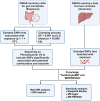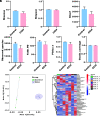Causal Relationship Between Gut Microbiota and Liver Cirrhosis: 16S rRNA Sequencing and Mendelian Randomization Analyses
- PMID: 38343609
- PMCID: PMC10851076
- DOI: 10.14218/JCTH.2023.00259
Causal Relationship Between Gut Microbiota and Liver Cirrhosis: 16S rRNA Sequencing and Mendelian Randomization Analyses
Abstract
Background and aims: Accumulating evidence highlights the association between the gut microbiota and liver cirrhosis. However, the role of the gut microbiota in liver cirrhosis remains unclear.
Methods: We first assessed the differences in the composition of the bacterial community between CCl4-induced liver cirrhosis and control mice using 16S rRNA sequencing. We then performed a two-sample Mendelian randomization (MR) analysis to reveal the underlying causal relationship between the gut microbiota and liver cirrhosis. Causal relationships were analyzed using primary inverse variance weighting (IVW) and other supplemental MR methods. Furthermore, fecal samples from liver cirrhosis patients and healthy controls were collected to validate the results of the MR analysis.
Results: Analysis of 16S rRNA sequencing indicated significant differences in gut microbiota composition between the cirrhosis and control groups. IVW analyses suggested that Alphaproteobacteria, Bacillales, NB1n, Rhodospirillales, Dorea, Lachnospiraceae, and Rhodospirillaceae were positively correlated with the risk of liver cirrhosis, whereas Butyricicoccus, Hungatella, Marvinbryantia, and Lactobacillaceae displayed the opposite effects. However, the weighted median and MR-PRESSO estimates further showed that only Butyricicoccus and Marvinbryantia presented stable negative associations with liver cirrhosis. No significant heterogeneity or horizontal pleiotropy was observed in the sensitivity analysis. Furthermore, the result of 16S rRNA sequencing also showed that healthy controls had a higher relative abundance of Butyricicoccus and Marvinbryantia than liver cirrhosis patients.
Conclusions: Our study provides new causal evidence for the link between gut microbiota and liver cirrhosis, which may contribute to the discovery of novel strategies to prevent liver cirrhosis.
Keywords: 16S rRNA gene sequencing; Causality; Gut microbiota; Liver cirrhosis; Two-sample Mendelian randomization study.
© 2024 Authors.
Conflict of interest statement
The authors have no conflict of interests related to this publication.
Figures






Similar articles
-
Roles of Human Gut Microbiota in Liver Cirrhosis Risk: A Two-Sample Mendelian Randomization Study.J Nutr. 2024 Jan;154(1):143-151. doi: 10.1016/j.tjnut.2023.11.011. Epub 2023 Nov 19. J Nutr. 2024. PMID: 37984746
-
Causal effect of gut microbiota on Gastroduodenal ulcer: a two-sample Mendelian randomization study.Front Cell Infect Microbiol. 2023 Dec 8;13:1322537. doi: 10.3389/fcimb.2023.1322537. eCollection 2023. Front Cell Infect Microbiol. 2023. PMID: 38156322 Free PMC article.
-
Insight into the Causal Relationship between Gut Microbiota and Back Pain: A Two Sample Bidirectional Mendelian Randomization Study.Adv Genet (Hoboken). 2023 Nov 8;4(4):2300192. doi: 10.1002/ggn2.202300192. eCollection 2023 Dec. Adv Genet (Hoboken). 2023. PMID: 38099244 Free PMC article.
-
Uncovering a causal connection between the Lachnoclostridium genus in fecal microbiota and non-alcoholic fatty liver disease: a two-sample Mendelian randomization analysis.Front Microbiol. 2023 Dec 12;14:1276790. doi: 10.3389/fmicb.2023.1276790. eCollection 2023. Front Microbiol. 2023. PMID: 38192292 Free PMC article.
-
Exploring the potential causal relationship between gut microbiota and heart failure: A two-sample mendelian randomization study combined with the geo database.Curr Probl Cardiol. 2024 Feb;49(2):102235. doi: 10.1016/j.cpcardiol.2023.102235. Epub 2023 Nov 30. Curr Probl Cardiol. 2024. PMID: 38040216 Review.
Cited by
-
Astragalus Polysaccharide Enhances Voriconazole Metabolism under Inflammatory Conditions through the Gut Microbiota.J Clin Transl Hepatol. 2024 May 28;12(5):481-495. doi: 10.14218/JCTH.2024.00024. Epub 2024 Apr 19. J Clin Transl Hepatol. 2024. PMID: 38779521 Free PMC article.
-
The Impact of Gut Microbiota on Chronic Obstructive Pulmonary Disease: A Dual-Sample Mendelian Randomization Study.Int J Chron Obstruct Pulmon Dis. 2025 Jun 17;20:1983-1993. doi: 10.2147/COPD.S511383. eCollection 2025. Int J Chron Obstruct Pulmon Dis. 2025. PMID: 40547287 Free PMC article.
References
-
- Zheng Y, Chen S, Huang Y, Jiang L, Li Y, Lan Y, et al. Prevalence and Severity of HBV-Associated Acute-on-Chronic Liver Failure Due to Irregular Medication of Nucleos(t)ide Analogs. Infect. Microbes Infect. 2021;3(4):205–209. doi: 10.1097/im9.0000000000000076. - DOI
-
- Collaborators GBDC. The global, regional, and national burden of cirrhosis by cause in 195 countries and territories, 1990-2017: a systematic analysis for the Global Burden of Disease Study 2017. Lancet Gastroenterol Hepatol. 2020;5(3):245–266. doi: 10.1016/S2468-1253(19)30349-8. - DOI - PMC - PubMed
LinkOut - more resources
Full Text Sources
